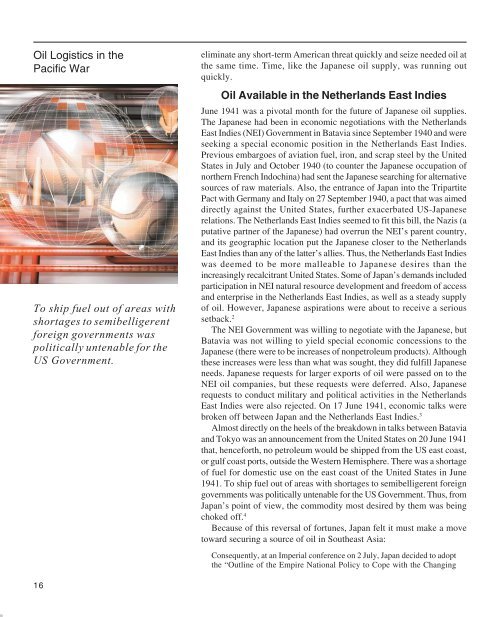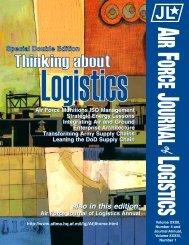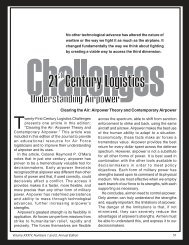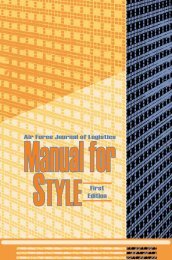Old Lessons, New Thoughts - AF Logistics Management Agency
Old Lessons, New Thoughts - AF Logistics Management Agency
Old Lessons, New Thoughts - AF Logistics Management Agency
You also want an ePaper? Increase the reach of your titles
YUMPU automatically turns print PDFs into web optimized ePapers that Google loves.
Oil <strong>Logistics</strong> in the<br />
Pacific War<br />
To ship fuel out of areas with<br />
shortages to semibelligerent<br />
foreign governments was<br />
politically untenable for the<br />
US Government.<br />
16<br />
eliminate any short-term American threat quickly and seize needed oil at<br />
the same time. Time, like the Japanese oil supply, was running out<br />
quickly.<br />
Oil Available in the Netherlands East Indies<br />
June 1941 was a pivotal month for the future of Japanese oil supplies.<br />
The Japanese had been in economic negotiations with the Netherlands<br />
East Indies (NEI) Government in Batavia since September 1940 and were<br />
seeking a special economic position in the Netherlands East Indies.<br />
Previous embargoes of aviation fuel, iron, and scrap steel by the United<br />
States in July and October 1940 (to counter the Japanese occupation of<br />
northern French Indochina) had sent the Japanese searching for alternative<br />
sources of raw materials. Also, the entrance of Japan into the Tripartite<br />
Pact with Germany and Italy on 27 September 1940, a pact that was aimed<br />
directly against the United States, further exacerbated US-Japanese<br />
relations. The Netherlands East Indies seemed to fit this bill, the Nazis (a<br />
putative partner of the Japanese) had overrun the NEI’s parent country,<br />
and its geographic location put the Japanese closer to the Netherlands<br />
East Indies than any of the latter’s allies. Thus, the Netherlands East Indies<br />
was deemed to be more malleable to Japanese desires than the<br />
increasingly recalcitrant United States. Some of Japan’s demands included<br />
participation in NEI natural resource development and freedom of access<br />
and enterprise in the Netherlands East Indies, as well as a steady supply<br />
of oil. However, Japanese aspirations were about to receive a serious<br />
setback. 2<br />
The NEI Government was willing to negotiate with the Japanese, but<br />
Batavia was not willing to yield special economic concessions to the<br />
Japanese (there were to be increases of nonpetroleum products). Although<br />
these increases were less than what was sought, they did fulfill Japanese<br />
needs. Japanese requests for larger exports of oil were passed on to the<br />
NEI oil companies, but these requests were deferred. Also, Japanese<br />
requests to conduct military and political activities in the Netherlands<br />
East Indies were also rejected. On 17 June 1941, economic talks were<br />
broken off between Japan and the Netherlands East Indies. 3<br />
Almost directly on the heels of the breakdown in talks between Batavia<br />
and Tokyo was an announcement from the United States on 20 June 1941<br />
that, henceforth, no petroleum would be shipped from the US east coast,<br />
or gulf coast ports, outside the Western Hemisphere. There was a shortage<br />
of fuel for domestic use on the east coast of the United States in June<br />
1941. To ship fuel out of areas with shortages to semibelligerent foreign<br />
governments was politically untenable for the US Government. Thus, from<br />
Japan’s point of view, the commodity most desired by them was being<br />
choked off. 4<br />
Because of this reversal of fortunes, Japan felt it must make a move<br />
toward securing a source of oil in Southeast Asia:<br />
Consequently, at an Imperial conference on 2 July, Japan decided to adopt<br />
the “Outline of the Empire National Policy to Cope with the Changing





